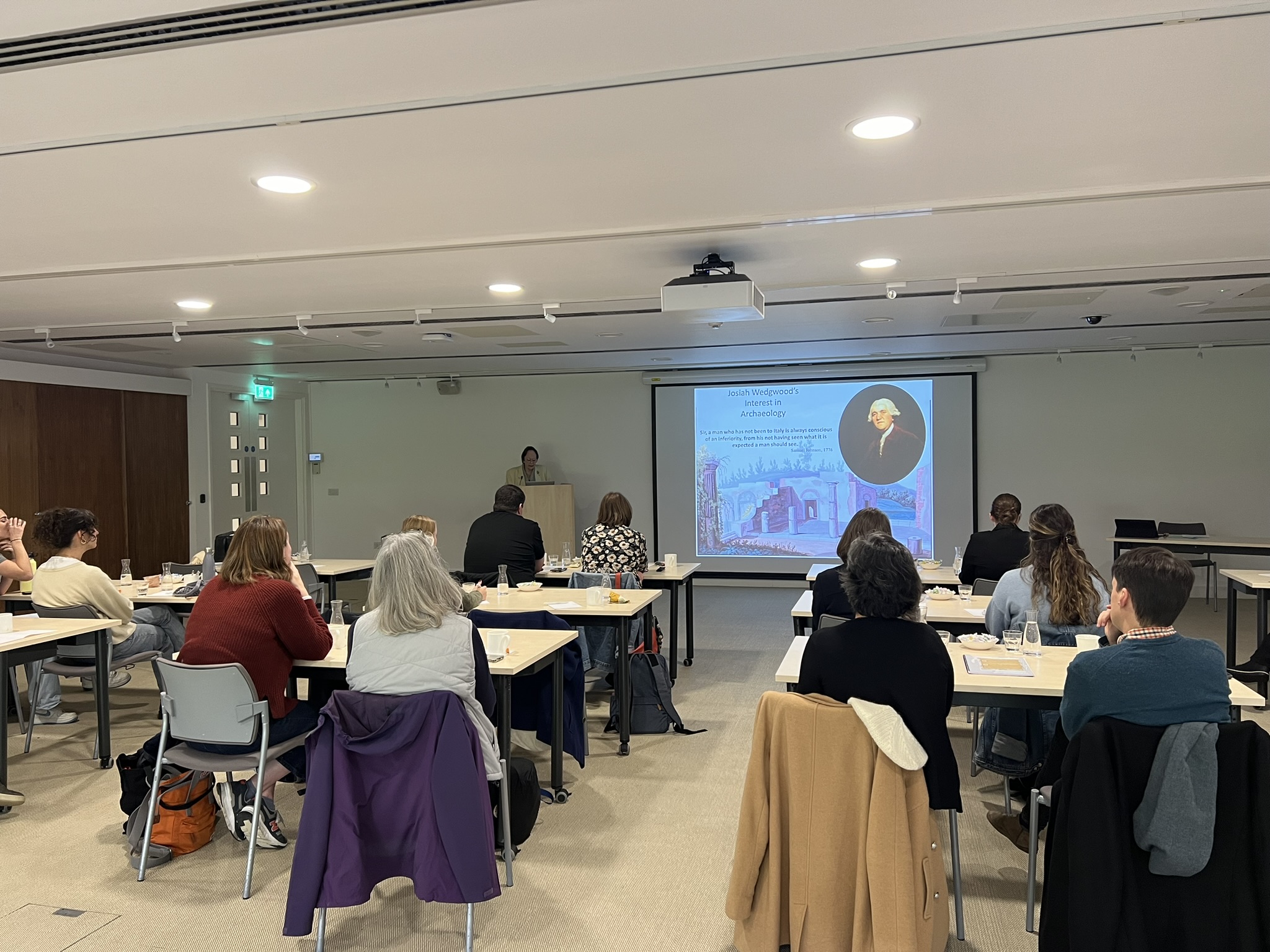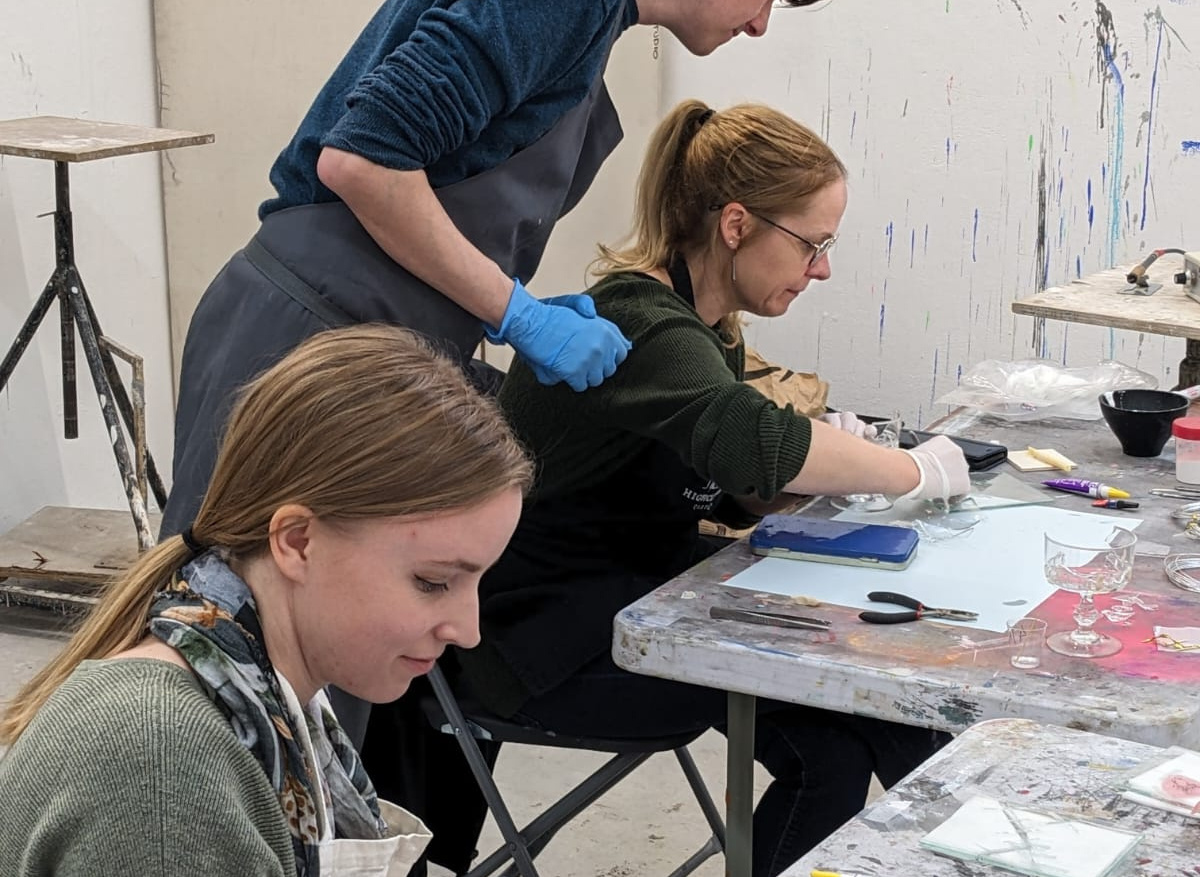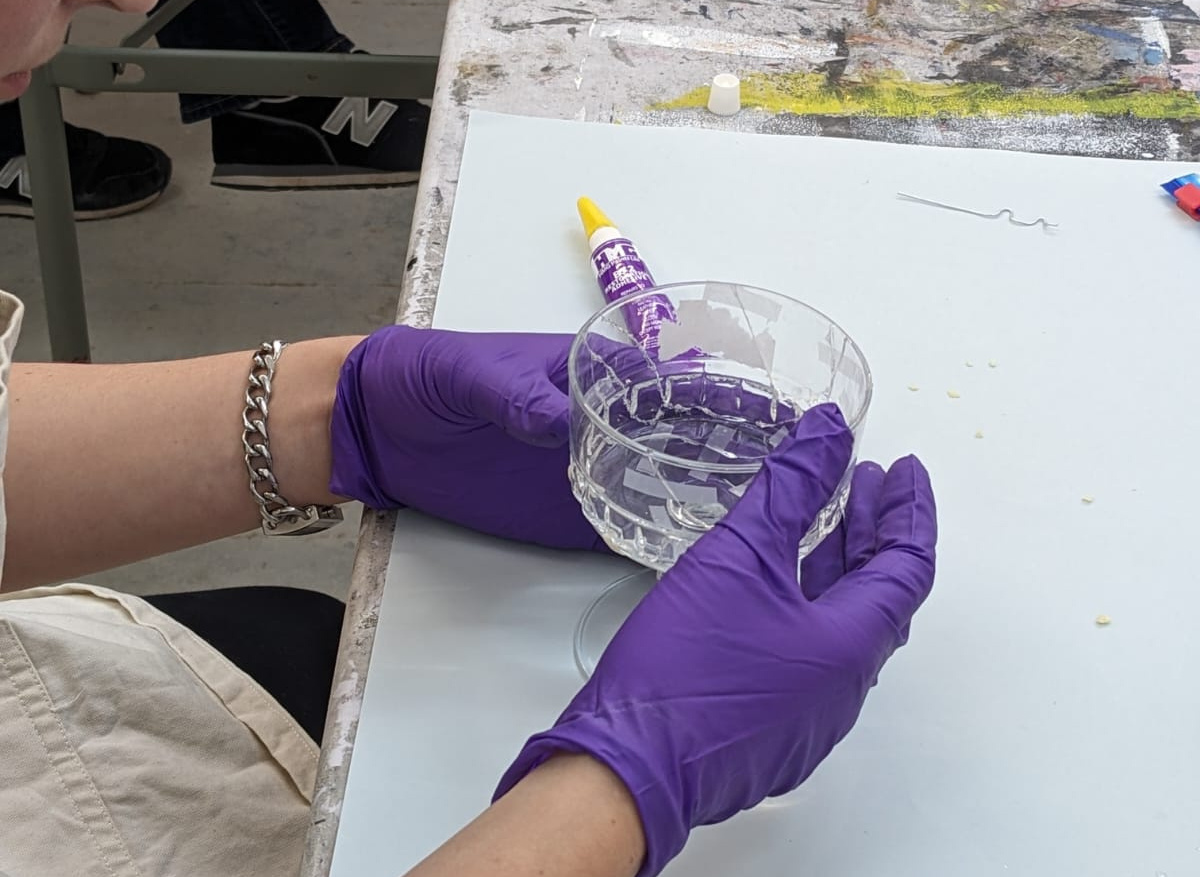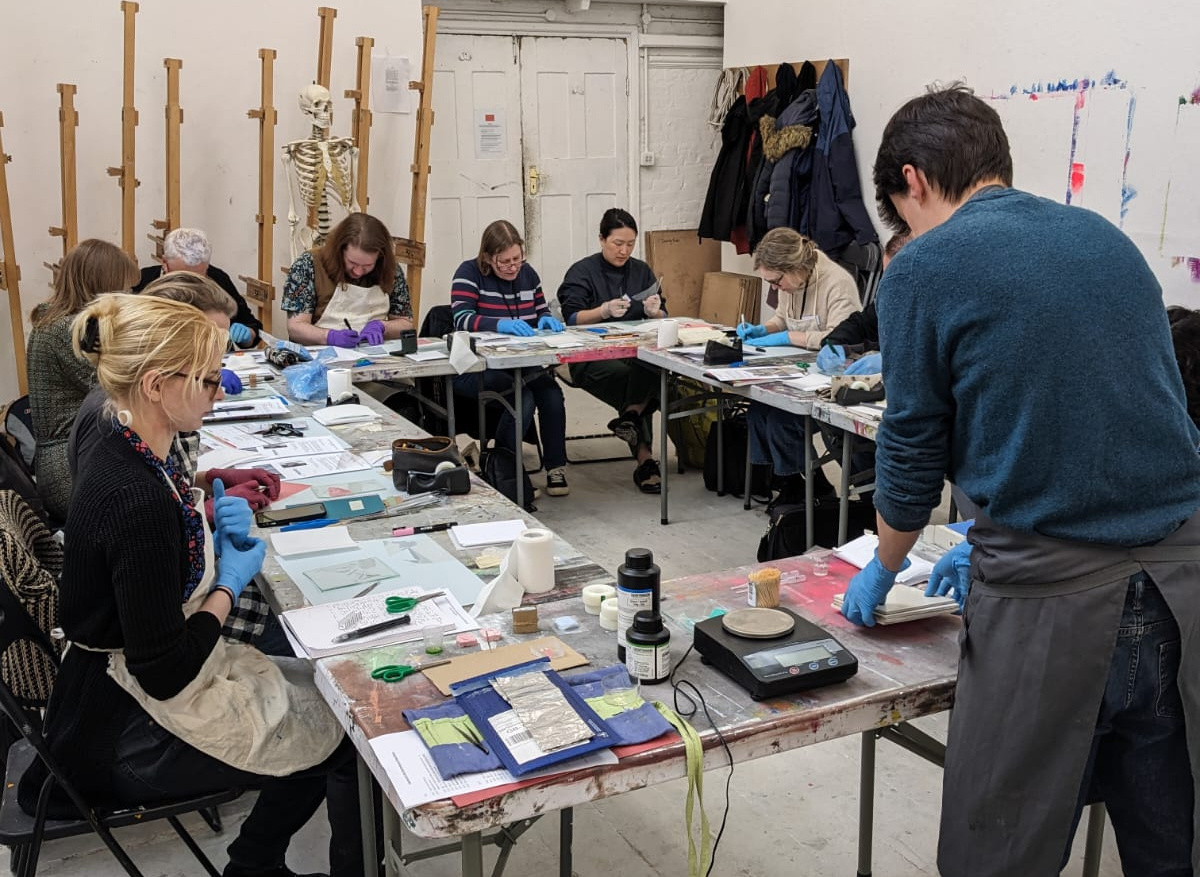2024
Glass Bonding & Filling Workshop (April 2024)
In April 2024, the Ceramics & Glass Group, in conjunction with the Stained Glass Group and Scotland Group, hosted a 3-day practical workshop lead by Tiago Oliveria, ACR with teaching support from Ros Hodges, ACR.
This course covered theory about glass degradation, conservation issues, conservation materials and techniques, and incorporated hands-on sessions on handling, bonding, mould making and filling flat glass and vessel glass surrogates. Tiago and Ros were also joined by Sarah Jarron, ACR who gave an insightful talk on the challenges of stained glass panels.
The workshop was successful in bringing together museum professionals from both the UK and abroad, and from various specialisms not limited to conservation. Participants gained an understanding of common glass conservation issues, and options and strategies for their conservation. It was also a wonderful networking opportunity and allowed us to once again interact in person.
Synergy Between Practical Conservation and Technology (July 2024)
As part of the Icon24 programming, the Ceramic & Glass Group held a lunchtime webinar.
We had two interesting lectures exploring the conservation of a rare 12th Century enameled Mosan Plaque found in Greater Manchester by metal detectorists in 2019 and the laser treatment of two reliefs from the Opificio delle Pietre Dure Museum in Florence where the use of emulsions and laser were combined to achieve an even cleaning of the terracotta.
2023
Autumn Meeting & AGM (October 2023)
On 14th October 2023, the Ceramics & Glass Group hosted their annual Autumn Meeting and AGM at the World of Wedgwood in Stoke-on-Trent.
It was a wonderful day that provided the opportunity to gather once again in person, hear lectures from two guest speakers, award this year’s Nigel Williams Prize, and explore the V&A Wedgwood collection.
The first guest speaker was Peter David, Emeritus ACR, who reflected on his long and successful 40-year career. He highlighted several wide-ranging projects and discussed how changes in conservation throughout the years influenced his approaches in terms of treatments and materials used.
The second guest speaker was Gaye Blake-Roberts, MBE. Gaye is the former director and curator of the Wedgwood Museum Trust. She gave an incredibly interesting talk which highlighted Josiah Wedgwood’s interest in archaeology and how this had a significant influence on his ceramic designs.
During this event, CGG also awarded the Nigel Williams Prize, and we had presentations about the Main Prize and Student Prize winning projects. Further information on these can be found on CGG’s NWP page here.

Student Lunchtime Lectures (2023)
The Ceramics and Glass Group hosted two very successful online Student Lunchtime Lectures on the 18th April 2023 and 4th May 2023 which provided an excellent opportunity to hear from the new generation of conservators and the types of projects they have been working on.
Speakers – 18 April 2023
Working with Historic Repairs: The Conservation of a Pair of Qing Dynasty Lidded Baluster Jars
Anna Crowther & Davina Thompson, Durham University, UK
Anna Crowther and Davina Thompson (both 2nd Year MA Conservation of Archaeological and Museum Objects, Durham University) will discuss the challenges presented by a pair of Lidded Baluster Jars with differing, unstable historic repairs. They will outline how solutions were found to show respect to historic treatments whilst improving the structural integrity and aesthetic appearance of each ceramic. Some of the challenges and successes include working with staples, adhesive identification and removal and reducing staining through use of poultices.
Findings on Structurally Supportive Fills for Archaeological Glass
Marceline Graham, University College London, UK
Marceline Graham is the 2022-2023 Conservator-in-Residence at Slade School of Fine Art. She is currently in her final year of UCL’s MSc Conservation for Archaeology and Museums, where she previously received her MA in Principles of Conservation. Prior to her return to university, Marceline was Associate Director at Ocula, a digital platform for contemporary art. Her current research centres on the potential of conservation knowledge-sharing, particularly within arts education. She will be presenting her findings from experimentation with archaeology glass fills during the treatment of a highly fragmented Islamic vessel, including adaptations from contemporary and historic methods.
Ubumba Olungashi: A Case Study of Unfired Ceramics by South African Artist Hezekiel Ntuli
Chelsea Roberts, University of Pretoria, South Africa
Chelsea Roberts is currently completing a master's degree in Tangible Heritage Conservation, at the University of Pretoria in South Africa. This programme is currently the only art and heritage conservation master’s degree in Southern Africa. The topic Chelsea is looking at is the South African artist Hezekiel Ntuli and his clay sculptures. Hezekiel Ntuli’s sculptures are made of unfired clay, an artistic medium fraught with conservation challenges. The main aim of the project is to develop treatment proposals and carry out conservation treatments for three small clay sculptures at the University of Pretoria Museums.
Pharmaceutical glass containers in the Swiss National Museum: Study and intervention protocol for the consolidation of cold painted inscriptions
Annick Simon, Haute École Arc, Switzerland
Annick Simon is a student in the final year of her Master’s degree in Conservation-restoration of archaeological, historical and ethnographic objects. With a bachelor’s degree in art history and social anthropology, she then grew an interest in conservation, wishing to participate actively in the preservation of heritage for future generations and to reconcile theory with practice. Alongside her studies, she has worked in museums such as the Bern History Museum, the Swiss National Museum and the Museum of History and Archeology in Lausanne (Switzerland). Her dream is to work one day in a dynamic institution that puts forward both tangible and intangible heritage.
Speakers – 4 May 2023
Operation under heat: Chlorakas – Palloures pottery conservation project
Chenyue Xu, University of Amsterdam, the Netherlands
Chenyue Xu is a second-year Master of Science student from the University of Amsterdam (UvA, the Netherlands), specializing in the Conservation and Restoration of Glass and Ceramics. Before coming to the UvA, she completed her graduate diploma in the conservation of ceramics and related materials at West Dean College (UK). This presentation tackles several aspects through her internship experience in the Palloures Pot Cluster Restoration Project in the summer of 2022 in Cyprus, which was part of the Palloures excavation project to support the investigation of building biographies of the Cypriot Chalcolithic. A number of questions are considered: What did the objects look like after excavation? How does conservation operate within an archaeological project? What is needed when working outside a studio setting? How does the conservation contribute to further archaeological research?
Thin and Shattered: Repairing a Roman Glass Beaker
Roisin Thompson, Durham University, UK
Roisin Hancock-Thompson is a recent graduate of the Durham University MA in the Conservation of Archaeological and Museum Objects. In 2021/2022, Roisin undertook her placement year at the National Museum of Wales with the supervision of Louise Mumford. Roisin is primarily interested in the rather diverse fields of glass and ceramic conservation, and paper conservation. This presentation explores the interventive treatment undertaken to repair a very thin, fragmented, archaeological glass beaker from Usk (Caerleon, Wales) to display status. This object had previously rejected conservation treatments over time and had been returned to the conservation studio a number of times. Due to the repeated failure of previous adhesives, the author turned to Paraloid B72 to adhere the pieces. In addition to this, the large areas of loss were infilled for the first time, using Paraloid B72 impregnated Japanese tissue as the fill. This was done with the hope of adding strength to the joins to prevent future collapse again.
The Vrolik Glass Project: Understanding Degradation Mechanisms in Glass Containers for Fluid Preserved Specimens
Ash Dupuis, Haute École Arc, Switzerland
Ash Dupuis (they/them) did their Bachelor’s at the Sorbonne University in Paris, and is currently finishing a Master’s degree in conservation at the Haute Ecole Arc in Neuchâtel, Switzerland. Their interests in conservation include archaeology, natural history, human remains and organic materials. For their thesis, Ash is studying the physical and chemical degradation mechanisms in glass used to hold fluid preserved specimens. The focus being on a neuroscientific collection from the early 20th century recently donated to the Vrolik Museum in Amsterdam. Their presentation will be on this ongoing project, sharing its current advancement as well as potential prospects for the study of glass in fluid collections.
A Work Placement at the Royal Oak Foundation Conservation Studio at Knole Park
Duncan McCall, West Dean College, UK
Duncan McCall is an MA student specialising in the conservation of ceramics and related materials at West Dean College. He had a previous career as a barrister, but was drawn to conservation through his interest in ceramics. This presentation will cover his experience of a 6-week work placement at the National Trust’s conservation studio at Knole Park in Kent, where objects of all types from the National Trust’s collections across the country are conserved.
Conserving Cartonnage/Conserving Papyrus: Two Egyptian Masks from the Greco-Roman Branch of the Egyptian Exploration Society
Maxim Chesnokov, University College London, UK
Max is a final-year intern student studying MSc Conservation for Archaeology and Museums at University College London (UCL). In this presentation, he will be talking about his cartonnage project on a pair of Ptolemaic cartonnage masks from the Egyptian Exploration Society (EES), which he carried out during the first half of his internship year at the UCL Culture laboratories, and the challenges and achievements that he has encountered whilst doing so. He will share a treatment progress report, documenting each stage of treatment from initial entry into the laboratory through to humidification and mounting, and present the analytical data that have been obtained through X-rays, FTIR, pXRF, and multispectral imaging surveys (including very exciting results with revealing faded inscriptions on recycled papyri used within the masks!). He will also discuss some of the ethical and practical issues encountered with this material, chiefly the problem of conserving the papyrus within or prioritising the masks as a whole, which is a central focus of his dissertation on the same topic.
2022
The Beirut Glass Project – Reconstructing the Past to Build a New Future
On the 19th December 2022, the Ceramics & Glass Group were joined by the Beirut Glass Project lead conservator Dr Duygu Camurcuoglu ACR, FIIC and project conservator Claire Cuyaubère for an evening webinar. Their presentation gave a unique insight into the practical conservation work and collaboration undertaken to ensure a future for this important collection. It was the final opportunity to hear from both conservators on this topic.
Talk Summary
On 4 August 2020, amid the severe damage caused by the blast at the port of Beirut, a display case with 74 archaeologically significant glass vessels at the American University of Beirut (AUB) Archaeological Museum fell face down onto the floor, shattering 72 objects into numerous pieces. This talk will tell the story of some of these vessels in Beirut and at the British Museum, from recovery to final conservation phase, and explain how the project emphasized international collaboration, training and outreach putting heritage conservation in focus.
Presentation Re-Imagined – CGG Autumn Meeting and AGM
On the 30th September 2022, the Ceramics and Glass Group hosted an Autumn Meeting “Presentation Re-Imagined” and AGM at the Royal Oak Foundation Conservation Studio, Knole House, Sevenoaks.
It was a great opportunity for everyone to gather once again in person. We heard three interesting presentations showcasing different approaches to conserving objects for new exhibition opportunities from our speakers. The afternoon included a tour of the Royal Oak Foundation Conservation Studio led by Emma Schmeucker, Conservation Studio Manager, as well as a tour of Knole House.
Speaker presentations:
Tiago Oliveira, Freelance Conservator, shared his experiences of retouching Majolica for re display at the Courtauld Institute “Combining mimetic and discernible retouching on two Majolica pieces for display”.
Felicity Bolton ACR, Objects Conservator at The Royal Oak Foundation Conservation Studio, talked about the conservation journey of the Ornamental Gardens from Sissinghurst Castle. These included two delicate decorative pieces made from semi-precious jewels, coral, glass, cloisonne and metal.
Ros Hodges ACR, Freelance Conservator, presented her case study of the conservation of two large Wedgwood Basalt Figures that normally reside at the Vyne in Hampshire but required considerable conservation for a long overseas journey to the Classic Black Exhibition at the MINT Museum, North Carolina, USA.
Stain Reduction of Ceramics In-person Workshop
A two-day workshop held twice in August 2022 at UCL. This was a follow up, in-person event to November’s online webinar on the same topic hosted by Lauren Fair.
This workshop provided an overview of the principles of stain reduction of ceramics. Lectures, including cleaning theory, materials and application methods, and shared case studies from years of practical experience, were paired with hands-on sessions that enabled participants to experiment with common reagents and poultice materials on stained ceramic test pieces.
2021
Stain Reduction of Ceramics Webinar
An online lecture on stain reduction delivered by Lauren Fair on 11th November 2021.
Talk Summary
The decision to reduce stains on ceramic objects can often be fraught with challenges: what is the nature of the stain? If I try to remove it and fail, could it become more visible? Do I risk leaving chemicals within the body that could cause harm later on? Does the stain hold intrinsic value to the object, and should I remove it at all?
This lecture addressed these questions and more by sharing the latest research on stain reduction of ceramics at Winterthur Museum and the University of Delaware (USA). The theory behind current protocols was explained in detail, and case studies were presented to offer a range of stain reduction scenarios experienced by the presenter for over a decade of teaching and public dissemination of this work.
Fragmented Stories: Case Studies in Ceramics, Glass and Stained Glass Conservation
The Ceramics and Glass group, together with the Stained Glass Group, hosted a 2-day online conference in October 2021.
The conference was an international forum of professionals and students, allowing sharing, discussion and dissemination of the latest research and projects on the conservation of ceramics, glass and stained glass. We hosted an exciting range of talks, interactive Q&A sessions, posters, tours and networking opportunities.
We were honoured to have guest presentations from:
- Dr Katie Harrison, “Picturing St Cuthbert: Reconstructing the Narrative of the St Cuthbert Window, York Minster” Conservation Research Officer, York Consortium for Conservation and Craftsmanship, United Kingdom.
- Julie Monique “From Notre-Dame de Paris to Nantes cathedral, how recent disasters question stained glass conservators’ work” MA student, University of Paris in conjunction with Laboratoire de Recherche des Monuments Historiques.
Speakers
Dr Laura Adlington, “Dating Nathan: The Oldest Stained Glass Window in England?” Scientist at Strainoptics, North Wales, Pennsylvania, United States of America.
Carlotta Cammelli, “The Oculus of York Minster and its Origins: An Investigation into Condition and Context” Graduate Conservator, Recclesia Stained Glass, Chester, United Kingdom.
Holly Daws, “Fragmented Histories: Deconstructing and Reconstructing a 17th Century Iranian stone-paste tile panel” Project Assistant Artefact Conservator, National Museums Scotland, Edinburgh, United Kingdom.
Dr Marta Kamińska, “Application of 3D scanning modelling and 3D printing technology in the reconstruction of a missing part of a Chinese Qing dynasty carved overlay glass vessel” Assistant Professor,Shanghai University of Engineering Science, China.
Antanas Melinis, “Conditions for the safe storage of early glass” PhD Candidate, University College London’s Institute of Archaeology, United Kingdom.
Margot Murray, “Repairing an Impossible Bottle: an experimental treatment approach to preserve artistic intent” Sherman Fairchild Foundation Conservation Fellow at The Metropolitan Museum of Art, New York, NY, United States of America.
Dr Dana Norris ACR, “From Dionysos to Bacchus and Back Again: Conservation of a Wedgwood Bust” Partner at Watt and Norris Conservation in Oxford, Visiting Fellow, Cranfield University Forensics Institute, Shrivenham, United Kingdom.
João Rolaça and Dr Inês Coutinho, “Touched by fire: Interdisciplinary study for the interpretation of the firing marks in ceramic wares” João Rolaça PhD candidate and Dr Inês Coutinho is Assistant Professor, Universidade Nova de Lisboa, Portugal.
Lucyna Tkaczyk, “Glass paintings in Tatra Muzeum- conservation issues resulting from their production technology” Conservator, Tatra Museum, Zakopane, Poland.
C. Montserrat Torres, “Stained glass in the Museum of Geology in Mexico City. The history behind the lights” Conservator, National Museum of Anthropology in Mexico City, Mexico.
Heide Trommer, “The study and conservation of key works of the Glass Museum Hentrich, in preparation for its redesigned and expanded permanent exhibition” Head of the Department of Applied Arts at the Düsseldorf Conservation Center, Düsseldorf, Germany.



